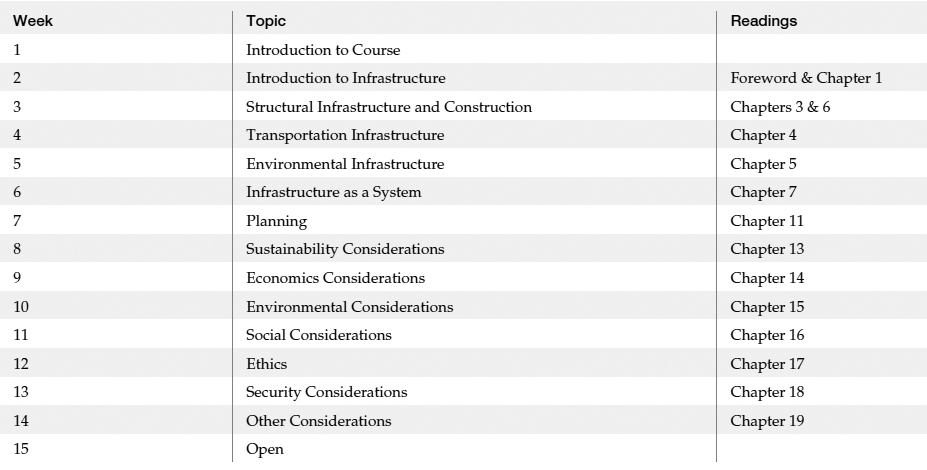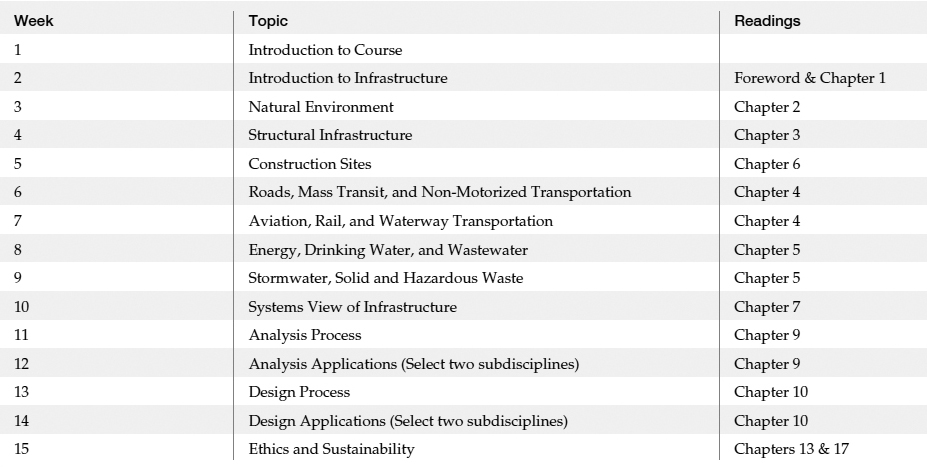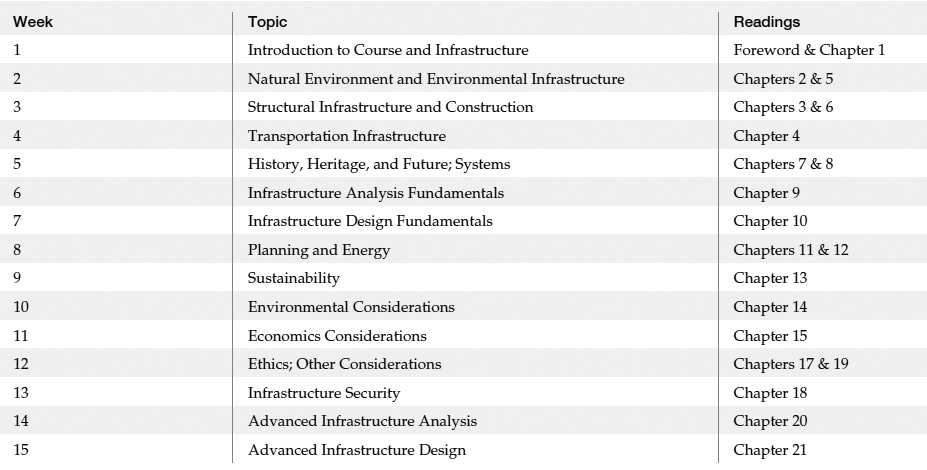Preface
Intended Audience
The target audience for this textbook is freshmen and sophomore civil and environmental engineering students. It is assumed that the reader has not yet taken courses in Calculus or Statics.
Goals and Motivation
Over the 15-week period of a typical college semester, the population of the United States will increase by approximately 700,000 people. This is roughly equivalent to the population of Charlotte, North Carolina, the 18th largest city in the U.S. During this same period, the world population will increase by approximately 21 million people, which is greater than the population of New York State, the third most populous state in the U.S. These semester-long numbers correspond to an annual growth in U.S. population of 2million and an annual growth in world population of 90 million people. Imagine the new infrastructure (the “built environment”) that must be constructed and the existing infrastructure that must be modified or expanded to meet the demands of these additional people: roads, rails, hospitals, power supplies, drinking water treatment facilities, schools, bridges, etc. And, even if the population was not growing, the need to build new or maintain existing infrastructure would still be necessary, as people move, the infrastructure ages and deteriorates, standards and regulations change, and user demands change (e.g., vehicle use and water use, on a per person basis).
Albert Einstein said, “we can't solve problems by using the same kind of thinking we used when we created them.” This belief has motivated us to write a textbook that not only teaches students the what of the infrastructure but also the how and the why of the infrastructure. In particular, students must be able to view the infrastructure as a system of interrelated physical components, and also understand how those components affect, and are affected by, society, politics, economics, and the environment.
We further believe that studying infrastructure allows educators and students to develop a valuable link between fundamental knowledge and the ability to apply that knowledge. In terms of Bloom's Taxonomy (a classification scheme for learning objectives within various levels of cognitive competence), infrastructure offers a bridge between Level 1 (Knowledge) and Level 3 (Application). Too often, we educators jump from the fundamental knowledge gained in lower level classes into the applications of upper level courses, without spending time to ensure that students grasp the meaning of the knowledge (Comprehension, Level 2) or are able to translate the knowledge into new contexts.
Some have made the analogy that in each course of the undergraduate curriculum, students are given a component with which to build a bicycle. Upon graduation, some students carry a box of parts across the stage, whereas others ride a bike across the stage. The latter have seen how the parts fit together. We feel that the infrastructure is an ideal means of introducing students to civil and environmental engineering, as it illustrates the interrelationships of the subdisciplines. We fear that all too often, students do not see how all the parts of civil and environmental engineering are interrelated until their senior year (or later). The topics and themes of this book are intended to help students see the “big picture” in the first or second year of the curriculum. Given this established foundation, subsequent coursework will be more meaningful.
Furthermore, engineers are stereotyped as not being holistic. Too often this stereotype holds true, and often results from a technical education that does not incorporate non-technical considerations. A substantial portion of this text is devoted to integrating these non-technical considerations into the design and analysis of infrastructure systems.
Unique Features
Several features unique to this textbook include:
- Introductory case studies—Most of the chapters open with a brief introduction, followed by an introductory case study. These case studies are revisited throughout the chapter in order to emphasize the learning objectives.
- Sidebars—Material is placed in the margins to enrich the content. Sidebars contain examples, definitions, “factoids,” and synopses of current events.
- Cases in point—Case studies, in addition to each chapter's introductory case study, are included throughout the textbook.
- Conversational style—Throughout the text, we have chosen to speak directly to the reader, using “we” to refer to ourselves, the authors, and “you” to refer to the reader. We recognize that this breaks with convention, but believe that it makes the material more accessible.
- Outro—An “outro” is the concluding section of a piece of music, and each chapter of this text concludes with an outro. It is intended to serve as a brief summary of the chapter and to introduce students to the next chapter or to the remainder of the textbook.
- Extensive graphics—This textbook includes more than 450 graphs, schematics, and photographs. We have purposely included photographs of some very commonplace components of our infrastructure, as experience has taught us that many first- and second-year students are unaware of the purpose of these components.
- Analysis and design applications—Four chapters are included that describe examples of how civil and environmental engineers analyze and design infrastructure components. Two of these chapters are presented at the introductory level midway through the textbook and two at a slightly more advanced level at the end of the textbook. These chapters are more calculation-intensive than the other chapters of the textbook.
- Icons—Icons are used in margins to alert students to additional information on the textbook website, including videos, articles, reports, photos, etc. Other icons identify the geographic location of places mentioned in the text.
- Facebook Page—A Facebook page, www.facebook.com/IntroductionToInfrastructure, has been formed. Infrastructure-related news items, at the appropriate technical level for the intended audience of this textbook, will be frequently posted.
Instructor Resources
The following resources are available to instructors on the book website:
- Solutions Manual—Solutions for homework problems are provided.
- Image Gallery—All figures, photographs, schematics, and graphs from the text are provided in electronic form.
Student Resources
The following resources are available to students (and instructors) on the textbook website:
- Image Gallery—Each photograph from the textbook is provided in color at a high resolution to overcome the limitations of the relatively small one-color photographs found in the textbook. Additional photographs are available, many of which are specifically referenced in sidebars.
Web Resources—These are referenced with icons (see example icon to the right), placed in the margins throughout the textbook.

- Video Gallery—A variety of brief videos are available on the textbook web-site.
- Tutorials—Examples include rudimentary spreadsheet functions, use of an engineering scale, etc.
- Facebook Page—Students can “Like” (i.e., become a fan of, or join) the textbook-companion Facebook page, www.facebook.com/IntroductionToInfrastructure, and receive frequent news updates related to infrastructure.
Acknowledgments
Much of the inspiration for this textbook has come from activities supported by two National Science Foundation grants (EEC 0530506—“Creating Citizen Engineers through Infrastructure Awareness” and DUE 0837530—“Infrastructure at the Forefront: Development and Assessment of Two Pilot Courses”) awarded to the Civil and Environmental Engineering Department at the University of Wisconsin-Platteville. Several of the department faculty members contributed to the textbook, either by adding content, providing ideas, or by reviewing portions of this textbook. Department faculty members who contributed to the grants and textbook development include: Max Anderson, Christina Curras, Kristina Fields, Andy Jacque, Mark Meyers, Tom Nelson, Sam Owusu-Ababio, Matt Roberts, Bob Schmitt, and Keith Thompson.
Two UW-Platteville students provided feedback on the chapters: Ben Heidemann and Steve Pritchett.
Michael Gay provided in-depth reviews of Chapters 11 and 14.
We are indebted to the many photographers who allowed us to use their photographs in this textbook.
Our editor, Jenny Welter, has been very supportive in all phases of the writing process.
We appreciate the insightful contributions of the following reviewers, whose efforts enhanced this book: Kristen Sanford Bernhardt, Lafayette College; Angela R. Bielefeldt, University of Colorado at Boulder; Fred Boadu, Duke University; Paul J. Consentino, Florida Institute of Technology; Anirban De, Manhattan College; David P. Devine, Infrastruct.Net Corp; Charles R. Glagola, University of Florida; Steven D. Hart, United States Military Academy; Rick Lyles, Michigan State University; Emmanuel U. Nzewi, Southern University and A&M College.
We wish to thank the many students over the years that have motivated us to become better teachers.
Finally, we wish to thank Mary, Charlie, Rebekah, Abigail, and Lydia.
Sample Syllabi
Sample syllabi for five possible courses are provided.
One-Credit Introduction to Civil and Environmental Engineering Course
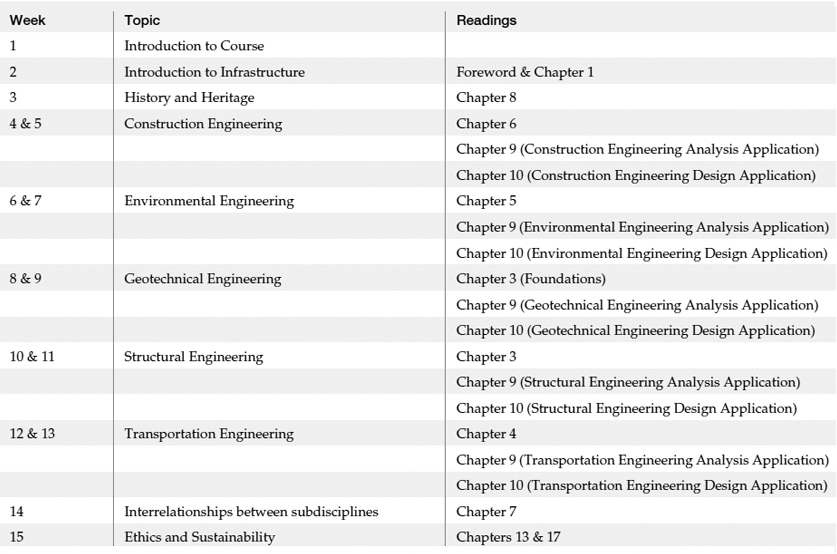
One-Credit Introduction to Infrastructure Course
Two-Credit Introduction to Civil and Environmental Engineering Course
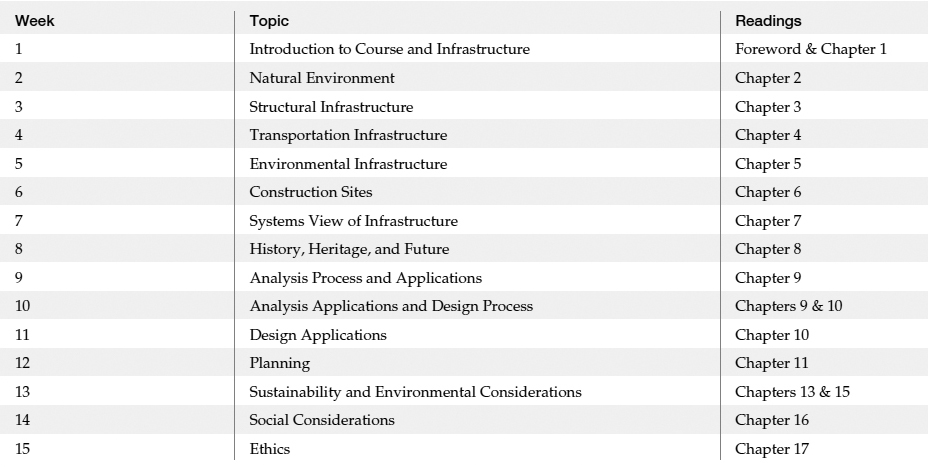
Three-Credit Introduction to Infrastructure Course
Three-Credit Capstone Design Course —Supplementary Text
